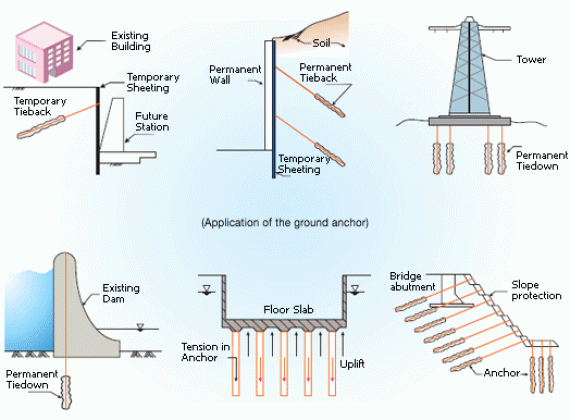Classification of Ground Anchors
Ground anchors are classified according to their service life, purpose, installation procedures and method of load transfer from the anchor to the ground. An anchor with a service life greater than 24 months is generally considered permanent. Permanent anchors shall always have some type of corrosion protection system based on the service life of the structure, the known aggressivity of the environment and corrosive properties of the soil and consequences of tendon failure.
Also, anchors can be classified into frictional type anchors that are supported by the friction of the grout and the ground, ground pressure type anchors that acquire anchoring force with the passive resistance of the ground using ground pressure boards or piles, and complex type anchors that are a combination of the above two types, based on the supporting method of the fixation ground. Frictional type anchors can also be classified into tensile type anchors and compressive type anchors based on the load application method to the grout. Lastly, compressive type anchors can be classified into load concentrative type anchors and load distributive type anchors depending on the distribution of the load.

We design and construct both permanent and temporary anchors using either multi-strand or stress bar in accordance with internationally recognised codes that have been adopted in New Zealand which include; British Standard Code of practice for Ground Anchorages BS8081:1989, Execution of special geotechnical work – Ground Anchors BS EN 1537:2000, FIP Design and construction of prestressed ground anchorages April 1996 and US Federal Highway Administration Geotechnical Engineering Circular No. 4 Ground Anchors and Anchored Systems June 1999.
We have an extensive database of ground anchor testing and geotechnical ultimate bond ruptures in a wide range of materials nationwide. However, in any ground anchoring project, site specific geotechnical investigations for the construction of the ground anchors are critical to minimise the risk profile for all parties. Access to this information means we are better able to qualify potential drilling difficulties and any potential for loss of grout from the drill hole during the anchor installation.
For multi-strand anchors, the strands are run through our specialist greasing and sheathing machine. This machine parts the individual wires of the strands followed by immersion into a grease bath before completely encapsulating the strand in the outer sheathing to ensure no voids are present.
We also provide mini-piles (drilled and grouted micro-piles up to 300mm diameter) which are structural supporting members that improve the stability and load bearing capacity of structures. These are constructed by drilling small diameter holes and constructing piles with high tensile steel and high compressive strength grouts to achieve tremendous load bearing capacities. Strengthening works commonly incorporate micro-piles to provide additional tension and or compression capacity to existing structures.
We utilise the technique of high-pressure (1000psi) post-grouting in weak compressible soils to significantly improve the bond capacity, and where required, fabric socks are used to ensure containment of grout within the drill hole thus ensuring full bond potential is realised.
Grouting Services, through its partnership with SAMWOO of Korea, offers world-leading ground anchor technology that includes:
- Removable, compressive, distributive anchors (SW-RCD)
- Permanent, tensile, distributive anchors (SW-SMART)
- Permanent, compressive, distributive anchors (SW-PCD)
- Permanent, tensile, frictional anchors (SW-PTF)
The load distributive compression (and tension) type removable anchors provide significant advantages to building owners as once the anchors are removed at the end of the project construction, there are no obstructions left in the ground that will conflict with any future developments.










